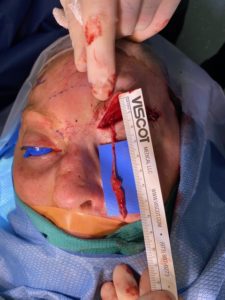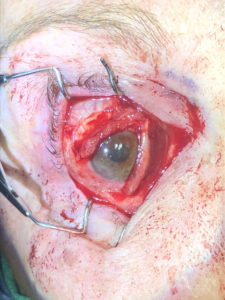Contributed By Ilya Leyngold, MD
Edited by Andrea Kossler, MD
Corneal neurotization (CN) surgery is a procedure performed to treat corneal anesthesia (numbness of the transparent front part of the eye covering the pupil and iris). Corneal anesthesia may result in a debilitating and visually threatening condition called neurotrophic keratopathy (NK), where affected individuals may develop corneal ulcerations, infections, and are at risk of losing vision. Corneal anesthesia may result from multiple causes. The most common culprits include certain viral infections (i.e. herpetic eye infections), radiation therapy, severe diabetes mellitus and brain tumors or surgery. It may also arise as a result of head trauma, complication of eye surgery, contact lens overuse, certain eye drops, or congenital defects.
Until recently no curative treatment existed for NK. Traditional treatments for NK include artificial tears, contact lenses to bandage the cornea, topical antibiotics or anti-inflammatory drops. Surgical treatments included suturing the eyelids closed (tarsorraphy) to prevent corneal perforation (developing a hole in the cornea) and various corneal grafting and transplant procedures. In 2009, the first scientific peer- reviewed article came out describing a case series of patients who underwent corneal neurotization. In this paper, the authors described a novel technique in which healthy donor nerves were “borrowed” from the other side of the face and transferred (i.e. “grafted”) to the affected eye. Although this procedure resulted in successful restoration of corneal sensation, improvement in vision and health of the cornea, it was quite invasive, requiring a large incision in the scalp, tedious dissection, and prolonged general anesthesia.
Less invasive corneal neurotization techniques are now available to achieve successful restoration of corneal sensation and improve vision. The indirect CN technique utilizes a nerve graft (either cadaveric or autograft) attached to a nearby healthy donor nerve isolated through a small lower or upper eyelid incision. The direct CN technique uses a small telescope (endoscope) to dissect the donor nerve and transfer it, directly, to the affected eye. Regardless of the particular technique used, it takes several months for nerve fibers to grow into the cornea and restore its sensation and healing capacity. During this time, the eye may need to be protected in selected patients by closing the lids with a suture.
Corneal neurotization is an outpatient surgery that can be performed under conscious sedation (twilight) or general anesthesia. Post-operative swelling and bruising around the eye(s) are common and take approximately 2-3 weeks to resolve. The numbness in the skin area from which the donor nerve is harvested may take several weeks to several months to improve, but generally returns to normal in most patients.
The photos below show a supraorbital nerve harvested from the left orbit, which is then tunneled under the bridge of the nose to innervate the right cornea.


References:
Elbaz U, Bains R, Zuker RM, et al. Restoration of corneal sensation with regional nerve transfers and nerve grafts: a new approach to a difficult problem. JAMA Ophthalmol 2014;132:1289–95.
Leyngold IM, Weller CM, Leyngold MM., Tabor, M. Endoscopic Corneal Neurotization: Technique and Initial Experience. Ophthalmic Plast Reconstr Surg. 2018 Jan/Feb;34(1):82-85.
Leyngold IM, Tabor M, Leyngold MM, Espana E. Endoscopic Corneal Neurotization: Cadaver Feasibility Study. Ophthalmic Plast Reconstr Surg. 2018 May/Jun;34(3):213-216.
Leyngold IM, Yen M, Tian J, Vora G, Leyngold M, Weller CM. Minimally invasive corneal neurotization with decellularized nerve graft: technique and clinical outcomes. Ophthalmic Plastic & Reconstructive Surgery. 2019 Mar/Apr;35(2):133-140.
Park JK, Charlson ES, Leyngold I, Kossler AL. Corneal Neurotization: A Review of Pathophysiology and Outcomes. Ophthalmic Plast Reconstr Surg. 2020 Sep/Oct;36(5):431-437.
Terzis JK, Dryer MM, Bodner BI. Corneal neurotization: a novel solution to neurotrophic keratopathy. Plast Reconstr Surg. 2009 Jan;123(1):112-20. doi: 10.1097/PRS.0b013e3181904d3a.
Wisely CE, Rafailov L, Cypen S, Proia AD, Boehlke CS, Leyngold IM. Clinical and Morphologic Outcomes of Minimally Invasive Direct Corneal Neurotization. Ophthalmic Plast Reconstr Surg. 2020 Sep/Oct;36(5):451-457.
